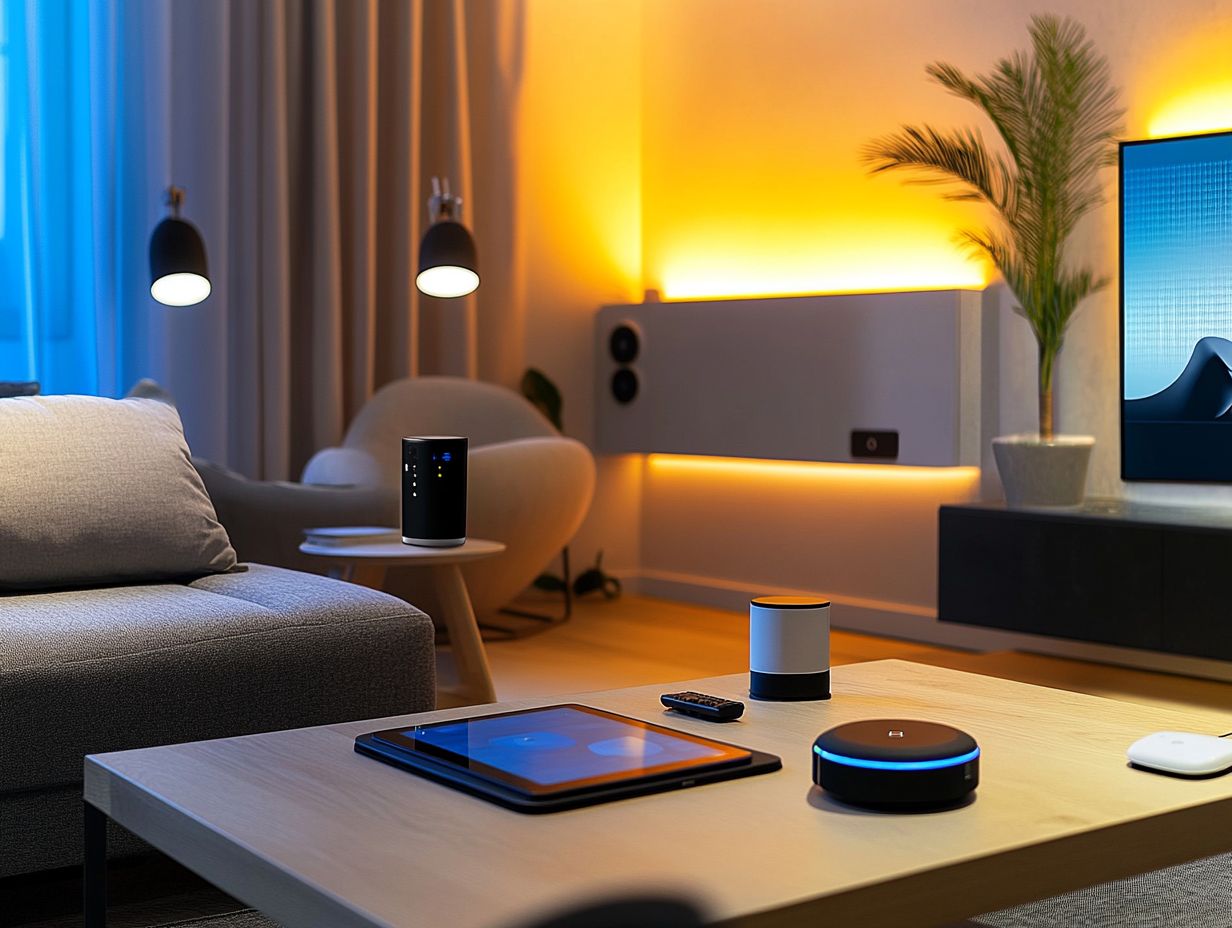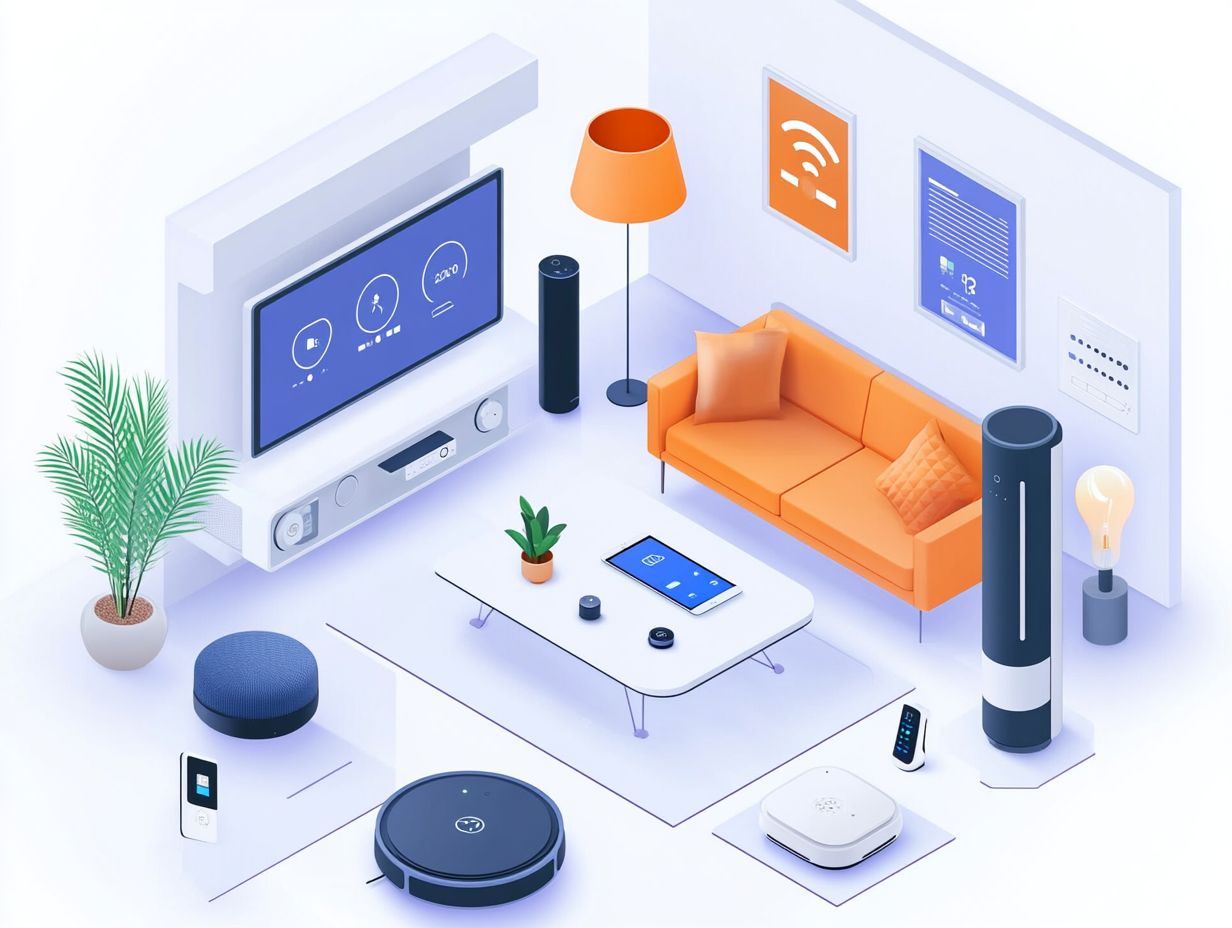Smart home upgrades enhance energy efficiency and security, providing a wide array of options such as intelligent lighting, smart thermostats, advanced security systems, and connected appliances. These upgrades utilize IoT devices and home automation to create a more connected and efficient living environment.
This article explores the different types of smart home upgrades, offers guidance on selecting the right options for your needs, and outlines the installation process, associated costs, and potential long-term savings. We also delve into the integration of home automation and IoT devices to enhance everyday living.
What are Smart Home Upgrades?

Smart home upgrades encompass a range of innovations and improvements that enhance the functionality, convenience, and efficiency of a household through the integration of home automation technologies, connected devices, and IoT solutions. These upgrades transform traditional homes into intelligent environments, allowing homeowners to manage their properties more efficiently while realizing significant energy savings.
Recent advancements in wireless communication and smart technology have led to the widespread adoption of various smart home upgrades, including devices such as smart thermostats, smart lighting, and security systems that collectively form a connected ecosystem powered by home automation and smart sensors.
Smart thermostats and sensors contribute to energy savings by learning user preferences and optimizing heating and cooling schedules. Meanwhile, smart lighting systems, applicable to both indoor and outdoor settings, can adjust brightness and color based on the time of day or specific activities.
Security enhancements, such as smart cameras and doorbell systems, provide real-time monitoring and alerts, ensuring safety from anywhere through a mobile app. Additionally, energy-efficient appliances like smart refrigerators and washing machines offer remote control options, streamlining tasks such as grocery shopping and laundry.
Overall, these technologies not only simplify our lives but also foster a more sustainable and eco-friendly home environment, promoting smart home benefits and smart home investment rewards.
Benefits of Making Your House More Connected: Smart Home Benefits
Transforming your home into a connected ecosystem offers numerous benefits. By integrating various smart home systems, such as smart lighting, smart thermostats, and home security solutions, you can leverage home automation technology to simplify daily tasks, enhance comfort, and improve overall home connectivity and energy management.
Additionally, the ability to monitor energy usage and control devices remotely promotes a sustainable lifestyle and can lead to significant cost savings over time.
Improved Convenience and Efficiency
The primary benefit of smart home upgrades is the enhanced convenience and efficiency they offer to homeowners. Automation systems and user-friendly mobile applications enable individuals to control connected devices, such as smart appliances, lighting, and security systems, from virtually anywhere, making routine tasks quicker and more efficient.
Smart thermostats simplify the monitoring and control of room temperatures, leading to improved energy efficiency and cost savings on utility bills, and provide essential home energy management functions.
This integration of smart technology not only enhances daily life but also provides peace of mind. For instance, homeowners can monitor smart security systems remotely, allowing them to check on their property from afar.
Motion-sensor lights automatically illuminate pathways, enhancing safety during nighttime walks, and can be integrated with smart home platforms for additional automation.
Additionally, voice-activated assistants facilitate hands-free control of devices, enabling users to turn off lights or adjust temperatures with simple voice commands.
These examples illustrate how well-designed smart home solutions can transform living spaces into hubs of convenience, promoting a more efficient and enjoyable lifestyle, and contributing to sustainable living.
Types of Smart Home Upgrades

Smart home upgrades refer to devices and systems designed to enhance home automation, energy management, and overall convenience, leveraging smart home technology and IoT devices to create a seamless living experience.
Examples of these upgrades include smart appliances such as refrigerators, stovetops, microwaves, ovens, washers, and dryers, which automate and simplify various kitchen and household tasks.
Smart security systems consist of smart locks, sensors, cameras, and alarm systems that monitor and secure residential properties, offering remote access and home monitoring capabilities.
Additionally, smart lighting systems feature smart bulbs and fixtures that allow homeowners to control the brightness and color of their lights.
Smart hubs play a crucial role by facilitating communication and control among multiple smart home devices and systems, ensuring smooth integration and interoperability within the smart home ecosystem.
Smart Lighting and Thermostat
Smart lighting and smart thermostats are among the most popular and impactful upgrades for smart homes, significantly enhancing both energy efficiency and user experience. By integrating these technologies into their households, individuals can enjoy increased convenience and a substantial reduction in energy bills.
The capability to set schedules or utilize scenes in smart lighting ensures that homeowners illuminate their spaces only when necessary, while color-changing features can be adjusted for various activities, such as reading or entertaining guests. Smart plugs can also be used to control lighting and other devices, adding another layer of convenience.
Meanwhile, smart thermostats learn user preferences over time and provide energy reports and tips, empowering users to make informed decisions regarding their heating and cooling usage. These devices often integrate with other smart home applications, enhancing overall home efficiency.
This seamless combination of automation and control optimizes comfort at minimal cost and demonstrates a clear pathway toward a more sustainable lifestyle.
Smart Security Systems
Smart security systems are essential upgrades that enhance home safety and provide peace of mind by integrating advanced technology with real-time monitoring capabilities, including the use of smart cameras and data privacy measures.
These systems typically include smart cameras, smart locks, and motion sensors, all of which can be accessed remotely through mobile apps, allowing homeowners to monitor their property from anywhere at any time.
With features such as geofencing and automated alerts, these systems not only deter potential intruders but also prioritize data privacy and security through encrypted wireless communication. Homeowners can create customized security protocols tailored to their unique needs.
Furthermore, integration with smart home ecosystems enables lighting, alarms, and even thermostat settings to work together, creating a safer environment. For example, programmable lighting can simulate occupancy, making it appear as though someone is home when they are not.
The efficiency and automation inherent in these systems significantly enhance overall convenience, ensuring that safety does not compromise the ease of living in today’s fast-paced world, thanks to advanced smart home protocols and automation systems.
Smart Appliances

Smart appliances are a key component of smart home technology, transforming the way people interact with and manage their living spaces by making everyday tasks more efficient and productive. They form an essential part of residential technology and home improvement.
For instance, smart refrigerators can help track available groceries, while smart ovens enable users to adjust cooking time and temperature through a mobile app. These appliances aim to simplify food preparation and overall home management.
As part of a broader home improvement strategy, smart appliances leverage artificial intelligence and networking to enhance both energy efficiency and user experience, contributing to the smart home ecosystem and sustainable living.
For example, smart washers and dryers offer cycle control and energy usage monitoring, which can save time and lower utility bills.
Smart thermostats can track user preferences and adjust heating and cooling schedules based on occupancy, leading to reported energy savings of 10 to 30 percent, according to the U.S. Department of Energy. Additionally, smart lighting systems that can be programmed or controlled via an app provide homeowners with greater flexibility, allowing them to set the mood for any occasion while simultaneously reducing electricity usage.
How to Choose the Right Smart Home Upgrades
When selecting smart home upgrades, there are several important factors to consider. First, you should assess your needs and expectations, whether they involve energy management, built-in security features, or convenience. Consider also the potential for home health monitoring and smart home devices review to aid in decision-making.
Additionally, consider the compatibility of new devices with your existing home systems and networks, as well as the potential for future expansion or integration with other devices. Ensure they comply with smart home standards and home automation protocols for seamless integration.
It’s also important to evaluate how easily you can control the new devices and how they communicate with one another.
Furthermore, take into account the upfront and ongoing costs associated with hardware, software, installation, and maintenance. As the market for home automation devices continues to grow, it’s essential to carefully evaluate your requirements and priorities to ensure you choose devices that will truly enhance your lifestyle.
Factors to Consider
Compatibility with existing home systems is essential for smart home devices to enhance interoperability among various devices in a connected ecosystem. This includes consideration of smart home platforms and home networking capabilities.
Evaluating energy consumption is also important; smart upgrades should be assessed not only for the convenience they provide but also for their contributions to energy efficiency and sustainability. User-friendliness is another key factor; smart home upgrades should be easy to use and feature an intuitive interface.
Budget considerations play a significant role in the decision-making process. Homeowners must determine whether the upfront costs of smart home upgrades align with the anticipated long-term savings on energy bills and maintenance expenses. Lifestyle needs should also be taken into account; for instance, a household with children may prioritize safety features, while a home occupied by tech-savvy young adults might favor automation, smart home technology, and adaptability.
Additionally, technology integration is crucial; smart home upgrades should be compatible with existing devices to ensure a seamless experience. A well-integrated system will adapt to various routines and preferences, enhancing overall user experience.
Installation and Set-Up Process for Smart Home Devices

The installation and setup process for smart home upgrades, including IoT devices and home automation systems, will vary based on the selected devices and the complexity of the home’s existing connectivity. Proper installation of automation systems is essential to ensure they function seamlessly and efficiently within the connected home environment.
User-friendly guidelines and mobile apps can greatly simplify the installation and setup process for homeowners, making the integration of smart home technology smoother.
Tips for a Smooth Smart Home Installation
To ensure a successful installation of smart home devices, consider the following tips: prioritize good device connectivity, use reliable user manuals, enhance installation with mobile apps, and maintain secure homes. The adaptability of smart home technology in everyday life is essential, and knowing how to set up these devices plays a key role in this process. Additionally, consider the use of smart hubs for better integration and smart home platforms for centralized control.
Here are the most important tips for installing smart home devices effectively:
- Device Connectivity: Position devices where they are most needed, particularly those that rely on a wireless network such as Wi-Fi. Ensure they are placed in areas with a strong Wi-Fi signal. To eliminate dead zones, consider using a mesh Wi-Fi system or range extenders, as the main router typically emits a Wi-Fi signal only within a limited radius. If a device is located outside this range, the Wi-Fi signal may be weak or nonexistent, hindering performance. Adding a range extender can help relay the signal to the desired location.
- Reliable User Manuals: Most manufacturers provide user manuals with comprehensive information on installation and usage. However, not all manuals are user-friendly. When selecting products, choose those from manufacturers known for providing clear and understandable user manuals.
- Enhanced Installation via Mobile Apps: Today, most smart home devices come with accompanying mobile apps, which are often the primary means of user interaction. These apps can simplify the installation process by offering guided setup features and enabling remote access to the devices. They also facilitate troubleshooting; for instance, a home security camera can send a notification to the app if it loses its Wi-Fi connection. Smart plugs and smart sensors can also be managed more efficiently via these apps, improving overall home connectivity.
- Secure Homes: Smart home devices are part of a connected ecosystem. If any component is left vulnerable, it may compromise the functionality of the entire system. For example, a weak security key on the home Wi-Fi network can allow hackers access to all connected devices, including smart locks and smart cameras. Regularly updating the software and firmware of all devices is crucial. Additionally, it’s important to restrict access to the main controls of smart home systems to prevent misuse, especially by children who may unintentionally disrupt settings, such as turning off the smart thermostat.
- Periodic Performance Checks: Most smart home devices require routine maintenance and performance checks, which may involve changing air filters on smart thermostats, cleaning the lenses of security cameras, or servicing the sensors on smart irrigation systems. Establishing a routine for these checks will help keep devices in optimal working condition and prevent issues before they arise. If a device malfunctions, contact customer service with the following information on hand: device model and version number, type of internet connection (wired, Wi-Fi, cellular), type of router or hub, and, if applicable, which virtual assistant (e.g., Amazon Alexa, Google Assistant, Apple Siri) is being used, along with a list of other connected devices. Additionally, using data privacy measures can protect the collected data.
Cost and Savings of Smart Home Upgrades and Investments
Understanding the costs and potential savings of smart home upgrades is essential for homeowners considering a transition to a connected home. While smart devices such as smart thermostats and smart security systems can be pricey, they often provide long-term benefits through enhanced energy efficiency and reduced utility bills. Home automation systems also contribute to home improvement and overall convenience.
Additionally, the convenience and security offered by these systems add significant value on their own, making them worthy investments for home automation trends and lifestyle improvement.
Initial Investment and Long-Term Savings in Smart Home Upgrades
The initial investment in smart home upgrades can vary significantly based on the types and number of devices chosen; however, this upfront cost should be weighed against the potential for long-term savings and overall home efficiency.
Smart home solutions, such as energy management systems and energy-efficient appliances, can significantly reduce energy consumption, resulting in lower utility bills over time. Homeowners can recoup their investments by selecting upgrades that align with energy-saving goals and sustainable living practices.
The increasing popularity of smart thermostats and automated lighting systems demonstrates how technology can adjust energy usage in real-time based on user preferences and schedules. This not only lowers costs in the short term but also contributes to sustainability by reducing one’s carbon footprint. Moreover, integration with smart grid technology can enhance these benefits.
Many homeowners discover that implementing these smart systems can yield substantial returns on investment, making it essential to consider both the initial expenses and the long-term benefits. Choosing reputable brands and ensuring proper installation can further enhance these returns, resulting in a decision that is both environmentally and financially beneficial. This consideration is crucial for smart home investment and home enhancement strategies.


